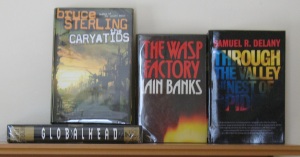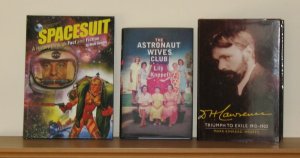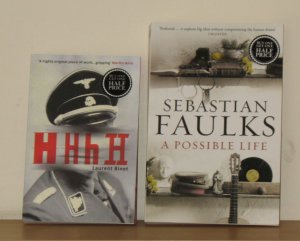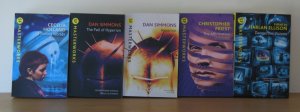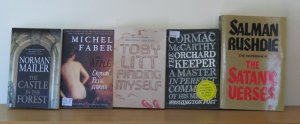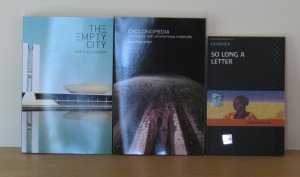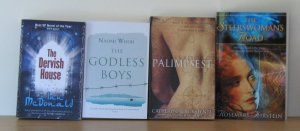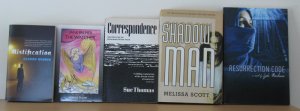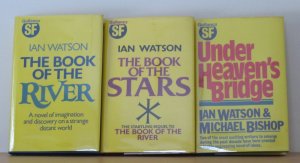It might look I had a run of books by male authors, but in amongst these were several sf novels by female writers, which I plan to review on SF Mistressworks soon-ish. As it is, there are two books by a single writer, Eric Brown, who’s a friend of many years: a novella and a short collection.
 Exalted on Bellatrix 1, Eric Brown (2017, UK). This is the final book in the Telemass Quartet, in which obsessive father Hendrick chases after the body of his young daughter, who has been put in stasis until a cure for her condition can be found, and who has been kidnapped by Hendrick’s ex-wife. And she is apparently just as warped as she’s been subjecting her daughter to increasingly desperate remedies, none of which have worked. But this is the fourth novella of a quartet, and Brown rarely fails to deliver some sort of uplifting closure to the agonies through which he puts his protagonists. In this one, Brown uses a setting he’s used many times in the past, an artists’ colony. Hendrick’s ex-wife has taken their daughter to the eponymous planet, where they’re hoping the reclusive, but advanced, alien inhabitants, the Vhey, will cure her. The end result is something in which the quartet’s story arc feels almost incidental. The novella focuses on the head of the colony, who is a nasty piece of work, and whose wife died in mysterious circumstances, and who plans to make use of the secret of the Vhey. Although not in the way Hendrick’s ex-wife is expecting, and not in a way that will save the daughter. Of the four novellas, this was probably the least satisfying, chiefly because it feels a bit warmed-over in places. Also, annoyingly, the previous three books used Roman numerals in their titles, but this one uses an Arabic number 1.
Exalted on Bellatrix 1, Eric Brown (2017, UK). This is the final book in the Telemass Quartet, in which obsessive father Hendrick chases after the body of his young daughter, who has been put in stasis until a cure for her condition can be found, and who has been kidnapped by Hendrick’s ex-wife. And she is apparently just as warped as she’s been subjecting her daughter to increasingly desperate remedies, none of which have worked. But this is the fourth novella of a quartet, and Brown rarely fails to deliver some sort of uplifting closure to the agonies through which he puts his protagonists. In this one, Brown uses a setting he’s used many times in the past, an artists’ colony. Hendrick’s ex-wife has taken their daughter to the eponymous planet, where they’re hoping the reclusive, but advanced, alien inhabitants, the Vhey, will cure her. The end result is something in which the quartet’s story arc feels almost incidental. The novella focuses on the head of the colony, who is a nasty piece of work, and whose wife died in mysterious circumstances, and who plans to make use of the secret of the Vhey. Although not in the way Hendrick’s ex-wife is expecting, and not in a way that will save the daughter. Of the four novellas, this was probably the least satisfying, chiefly because it feels a bit warmed-over in places. Also, annoyingly, the previous three books used Roman numerals in their titles, but this one uses an Arabic number 1.
 Revenger, Alastair Reynolds (2016, UK). This is, I think, supposed to be a YA novel – or at least YA-ish. The narrator is a teenage girl, in a planetary system populated by billions of space habitats, and which as been colonised in waves over billions of years. It is, it must be said, a pretty cool piece of world-building. Except… it’s all a bit steampunk. The spacecraft use light-sails to travel around the system, the technology is all brass and clockwork, except for magical tech artefacts left behind by aliens from earlier waves of colonisation… One of which are the skulls. Although the alien race whose skulls they were has long since vanished, and all that remains of them are bones, the technology inside their skulls remains active, and they’re all plugged into some sort of FTL comms network. Some teenagers can eavesdrop on this network, and send signals. Both Fura Ness and her sister Adrana have this knack. Adrana, the older of the two, persuades her sister to join her in running away from their financially-ruined father and making their fortune as skull readers. They join the crew of a ship that raids “baubles”, abandoned repositories of ancient alien tech (perhaps the baubles were habitats in the distant past, it’s never entirely clear). The baubles are usually secure behind impenetrable shields, but the shields occasionally drop for short periods, and some people are able to predict when these windows of opportunity will occur and how long they will last (again, it’s never made entirely clear why the shields should do this; because plot, I guess). Unfortunately, at their first bauble, the ship is attacked by a semi-legendary pirate, Bosa Sennen, who takes Adrana to be her skull-reader, and kills everyone else. But Fura hid, and survives. She vows revenge on the pirate, but her plans are derailed when her father has her brought back home and has a doctor halt her ageing so she will remain under-age and under his control. To me, that was the most horrifying part of the whole novel – Fura imprisoned by her age and society. Of course, Fura breaks free, joins the crew of a ship, engineers an encounter with Bosa Sennen and, well, there are no real surprises at the climax. As I said, the world-building is cool, but it’s never really convincing – and the baubles reminded me of something, A Deepness in the Sky perhaps? – and I didn’t really like the faux Victoriana. Fura makes for a good protagonist, but I thought the violence over-done. There is, I believe, a sequel called Revealer, due next year or the year after. I’ll buy it, of course.
Revenger, Alastair Reynolds (2016, UK). This is, I think, supposed to be a YA novel – or at least YA-ish. The narrator is a teenage girl, in a planetary system populated by billions of space habitats, and which as been colonised in waves over billions of years. It is, it must be said, a pretty cool piece of world-building. Except… it’s all a bit steampunk. The spacecraft use light-sails to travel around the system, the technology is all brass and clockwork, except for magical tech artefacts left behind by aliens from earlier waves of colonisation… One of which are the skulls. Although the alien race whose skulls they were has long since vanished, and all that remains of them are bones, the technology inside their skulls remains active, and they’re all plugged into some sort of FTL comms network. Some teenagers can eavesdrop on this network, and send signals. Both Fura Ness and her sister Adrana have this knack. Adrana, the older of the two, persuades her sister to join her in running away from their financially-ruined father and making their fortune as skull readers. They join the crew of a ship that raids “baubles”, abandoned repositories of ancient alien tech (perhaps the baubles were habitats in the distant past, it’s never entirely clear). The baubles are usually secure behind impenetrable shields, but the shields occasionally drop for short periods, and some people are able to predict when these windows of opportunity will occur and how long they will last (again, it’s never made entirely clear why the shields should do this; because plot, I guess). Unfortunately, at their first bauble, the ship is attacked by a semi-legendary pirate, Bosa Sennen, who takes Adrana to be her skull-reader, and kills everyone else. But Fura hid, and survives. She vows revenge on the pirate, but her plans are derailed when her father has her brought back home and has a doctor halt her ageing so she will remain under-age and under his control. To me, that was the most horrifying part of the whole novel – Fura imprisoned by her age and society. Of course, Fura breaks free, joins the crew of a ship, engineers an encounter with Bosa Sennen and, well, there are no real surprises at the climax. As I said, the world-building is cool, but it’s never really convincing – and the baubles reminded me of something, A Deepness in the Sky perhaps? – and I didn’t really like the faux Victoriana. Fura makes for a good protagonist, but I thought the violence over-done. There is, I believe, a sequel called Revealer, due next year or the year after. I’ll buy it, of course.
 The Paperchase, Marcel Theroux (2001, UK). I stumbled across this in a charity shop, and having been impressed by the last Theroux novel I read, Strange Bodies, I bought it. It’s not science fiction in the slightest, more of a family drama slash mystery. The narrator is a UK-based American, who is surprised to discover he’s been left his uncle’s house on a New England island in a will. The uncle was a celebrated writer, who faded away and became a recluse. The narrator leaves his job at the BBC and goes to live in the house – it’s a condition of the will: he only gets to keep it if he lives in it. And something about the papers left by his uncle, and the stories, and histories, of his neighbours, persuades the narrator there is a deeper story here – a mytsery about his uncle’s death, or his life. From a variety of unrelated facts, and assorted residents of the island, and friends of the late uncle, the narrator figures out the secret at the heart of the family. The problem is the prose, and the narrator, is so laid-back the revelation doesn’t really have the impact it should. True, it’s not especially earth-shattering, and very personal, but it’s the point of the novel so I’d expected something with more consequence. There’s a nicely digressive tone to the narrative, and the characters are well-drawn (and mostly likeable), but I polished this off about as quickly as I would a commericial crime novel and I had expected more of it.
The Paperchase, Marcel Theroux (2001, UK). I stumbled across this in a charity shop, and having been impressed by the last Theroux novel I read, Strange Bodies, I bought it. It’s not science fiction in the slightest, more of a family drama slash mystery. The narrator is a UK-based American, who is surprised to discover he’s been left his uncle’s house on a New England island in a will. The uncle was a celebrated writer, who faded away and became a recluse. The narrator leaves his job at the BBC and goes to live in the house – it’s a condition of the will: he only gets to keep it if he lives in it. And something about the papers left by his uncle, and the stories, and histories, of his neighbours, persuades the narrator there is a deeper story here – a mytsery about his uncle’s death, or his life. From a variety of unrelated facts, and assorted residents of the island, and friends of the late uncle, the narrator figures out the secret at the heart of the family. The problem is the prose, and the narrator, is so laid-back the revelation doesn’t really have the impact it should. True, it’s not especially earth-shattering, and very personal, but it’s the point of the novel so I’d expected something with more consequence. There’s a nicely digressive tone to the narrative, and the characters are well-drawn (and mostly likeable), but I polished this off about as quickly as I would a commericial crime novel and I had expected more of it.
 Strange Visitors, Eric Brown (2014, UK). This is the eighth volume in NewCon Press’s Imaginings series of short collections. The contents in this one were originally published in a variety of venues, but, as is usually the case with collections, one story is original. It is not, to be brutally honest, Brown’s strongest collection. ‘Life Beyond…’, a piece of Simakiana, hews so closely to Simak’s patterns the plot is obvious from the first page. ‘Steps Along the Way’ is a post-human story about a twentieth-century human reincarnated thirty thousand years later… just to set up a surprise reveal ending (I suppose I should have liked this one, given its plot, but I thought it weak). ‘Myths of the Martian Future’ is one of those sf stories where every character in it is an alien of some form. It felt lighter than its tone suggested. ‘The Scribe of Betelgeuse V’ felt more like Dr Who story than an Eric Brown one. But without Dr Who. Its tone suited its lightness. ‘The Rest is Speculation’ is set during the last days of planet Earth, and reads more like a travelogue than a story (and the header in the book is incorrect as it gives the title of the following story). Which is ‘The Tragic Affair of the Martian Ambassador’, a HG Wells / Sherlock Holmes mash-up, and succeeds as that if not entirely as a Holmes mystery. ‘Bukowski on Mars, With Beer’ was written for “bizarro fiction” anthology Vivisepulture (which also contained my Nazi occult flying saucer story, ‘Wunderwaffe’). I don’t know enough about Bukowski to feel qualified to comment on this story. ‘People of Planet Earth’ is one of those stories based on one of those silly ideas that wants to be both shocking and humorous, but fails at both. Finally, I was prepared to be disappointed by the collection’s only original story, ‘P.O.O.C.H.’, if only because of its terrible title. And prepared to hate it when I read that P.O.O.C.H. was an acronym for “Personal Omni-Operational Correctional Hound”, but… The premise is daft – giving convicted felons robot dogs programmed for bad behaviour in order to make them better people – but Brown draws his protagonists well and does a good job navigating the emotional landscape of the story. And yes, I also got to feel smug about being a cat person. It’s easily the best story in the collection.
Strange Visitors, Eric Brown (2014, UK). This is the eighth volume in NewCon Press’s Imaginings series of short collections. The contents in this one were originally published in a variety of venues, but, as is usually the case with collections, one story is original. It is not, to be brutally honest, Brown’s strongest collection. ‘Life Beyond…’, a piece of Simakiana, hews so closely to Simak’s patterns the plot is obvious from the first page. ‘Steps Along the Way’ is a post-human story about a twentieth-century human reincarnated thirty thousand years later… just to set up a surprise reveal ending (I suppose I should have liked this one, given its plot, but I thought it weak). ‘Myths of the Martian Future’ is one of those sf stories where every character in it is an alien of some form. It felt lighter than its tone suggested. ‘The Scribe of Betelgeuse V’ felt more like Dr Who story than an Eric Brown one. But without Dr Who. Its tone suited its lightness. ‘The Rest is Speculation’ is set during the last days of planet Earth, and reads more like a travelogue than a story (and the header in the book is incorrect as it gives the title of the following story). Which is ‘The Tragic Affair of the Martian Ambassador’, a HG Wells / Sherlock Holmes mash-up, and succeeds as that if not entirely as a Holmes mystery. ‘Bukowski on Mars, With Beer’ was written for “bizarro fiction” anthology Vivisepulture (which also contained my Nazi occult flying saucer story, ‘Wunderwaffe’). I don’t know enough about Bukowski to feel qualified to comment on this story. ‘People of Planet Earth’ is one of those stories based on one of those silly ideas that wants to be both shocking and humorous, but fails at both. Finally, I was prepared to be disappointed by the collection’s only original story, ‘P.O.O.C.H.’, if only because of its terrible title. And prepared to hate it when I read that P.O.O.C.H. was an acronym for “Personal Omni-Operational Correctional Hound”, but… The premise is daft – giving convicted felons robot dogs programmed for bad behaviour in order to make them better people – but Brown draws his protagonists well and does a good job navigating the emotional landscape of the story. And yes, I also got to feel smug about being a cat person. It’s easily the best story in the collection.
 The Quarry, Iain Banks (2013, UK). This was Banks’s last novel and is about a man dying of cancer, so questions about art and life were inevitable after Banks announced he had terminal cancer. The novel is actually narrated from the point of view of the dying man’s son, who has, I think, Asperger’s Syndrome. It is, like most of Banks’s non-M novels, a story based around a family secret, but the secret in this case is actually pretty irrelevant. A group of people who shared a house during their student days have returned to the house, where the oldest of their number now lives, and is in the end stages of terminal cancer. There is mention of a videocassette – the group fancied themselves as avant garde film-makers at university – which none of them want to see the light of day, but neither dying Guy nor his son Kit, know what’s happened to the tape. Meanwhile, a few home truths are aired, a few minor secrets from the past are let out of the bag, and the mystery of the identity of Kit’s mother is occasionally floated past the reader, only for it to be dealt with in passing at the end. The scene where the group view the sought-after videocassette is also pretty much a damp squib. The novel is narrated by Kit, and I don’t know enough about Asperger’s or autism to just how accurately or effectively he is portrayed. Other than that, Banks always wore his politics on his sleeve, and they’re out in full force in The Quarry. It’s far from his best novel, mainstream, science fiction or both, although it does come across as an angrier novel than his earlier ones (except perhaps for Complicity) – but that’s hardly surprising given what the Tories have been doing to the UK since 2010. Banks’s death makes The Quarry a more uncomfortable read than it would have been otherwise – the politics were clearly intended to make for uncomfortable reading for some, but the cancer aspect of the plot, sadly, overshadows it. Still, it’s a Bank novel, so it’s a given that it’s worth reading.
The Quarry, Iain Banks (2013, UK). This was Banks’s last novel and is about a man dying of cancer, so questions about art and life were inevitable after Banks announced he had terminal cancer. The novel is actually narrated from the point of view of the dying man’s son, who has, I think, Asperger’s Syndrome. It is, like most of Banks’s non-M novels, a story based around a family secret, but the secret in this case is actually pretty irrelevant. A group of people who shared a house during their student days have returned to the house, where the oldest of their number now lives, and is in the end stages of terminal cancer. There is mention of a videocassette – the group fancied themselves as avant garde film-makers at university – which none of them want to see the light of day, but neither dying Guy nor his son Kit, know what’s happened to the tape. Meanwhile, a few home truths are aired, a few minor secrets from the past are let out of the bag, and the mystery of the identity of Kit’s mother is occasionally floated past the reader, only for it to be dealt with in passing at the end. The scene where the group view the sought-after videocassette is also pretty much a damp squib. The novel is narrated by Kit, and I don’t know enough about Asperger’s or autism to just how accurately or effectively he is portrayed. Other than that, Banks always wore his politics on his sleeve, and they’re out in full force in The Quarry. It’s far from his best novel, mainstream, science fiction or both, although it does come across as an angrier novel than his earlier ones (except perhaps for Complicity) – but that’s hardly surprising given what the Tories have been doing to the UK since 2010. Banks’s death makes The Quarry a more uncomfortable read than it would have been otherwise – the politics were clearly intended to make for uncomfortable reading for some, but the cancer aspect of the plot, sadly, overshadows it. Still, it’s a Bank novel, so it’s a given that it’s worth reading.
 Go, Went, Gone, Jenny Erpenbeck (2015, Germany). After reading The End of Days, I knew Erpenbeck was a name to watch. So I tracked down her previous books and read them, and they were good. And now we have her latest, actually published In Germany in 2015, but the English translation is new this year. A retired professor in Berlin, and who grew up in East Germany, one day stumbles across a camp of African refugees in Alexanderplatz. He follows their story in the press as they are moved to a tent city in another square, and then split up and placed in temporary accommodation – mothballed schools and sanatoria – while the Berlin senate makes a decision on their fate. The professor decides to document the plight of these refugee men – from Libya, Ghana, and Niger, chiefly. There is a group of them in an old nursing home near his house, and he is allowed to interview them. As he gets to know them and their stories, so he realises that the narrative written by European governments and press about the refugees is both inaccurate and incomplete, in much the same way the powerful in Germany fostered a desire for unity and imposed their own narrative on the union of East and West. There are contrasts also – the initial easy acceptance of East Germans by West Germans, which soon soured, not to mention the expectations of the East Germans based on myths of the West propagated through Western culture. This is a book that properly interrogates its topic, and it pulls no punches. Right wing press and governments have traded on people’s racism and xenophobia to whip up anti-immigrant and anti-refugee sentiment that has no basis in fact – because people scared of strangers are easier to control and are less likely to notice when their rights and property are taken from them just so some oligarch can earn more money than he could possibly spend in a thousand lifetimes. They’re the ones we should be scared of, the oligarchs; they’re the ones we should hate – not the poor sods driven out of their homes by wars created by inept US foreign policy and British arms sales, or the economic depredations of Western corporations chasing profits, and organising violent regime changes, in the developing world to offset their decreasing margins in the developed world…
Go, Went, Gone, Jenny Erpenbeck (2015, Germany). After reading The End of Days, I knew Erpenbeck was a name to watch. So I tracked down her previous books and read them, and they were good. And now we have her latest, actually published In Germany in 2015, but the English translation is new this year. A retired professor in Berlin, and who grew up in East Germany, one day stumbles across a camp of African refugees in Alexanderplatz. He follows their story in the press as they are moved to a tent city in another square, and then split up and placed in temporary accommodation – mothballed schools and sanatoria – while the Berlin senate makes a decision on their fate. The professor decides to document the plight of these refugee men – from Libya, Ghana, and Niger, chiefly. There is a group of them in an old nursing home near his house, and he is allowed to interview them. As he gets to know them and their stories, so he realises that the narrative written by European governments and press about the refugees is both inaccurate and incomplete, in much the same way the powerful in Germany fostered a desire for unity and imposed their own narrative on the union of East and West. There are contrasts also – the initial easy acceptance of East Germans by West Germans, which soon soured, not to mention the expectations of the East Germans based on myths of the West propagated through Western culture. This is a book that properly interrogates its topic, and it pulls no punches. Right wing press and governments have traded on people’s racism and xenophobia to whip up anti-immigrant and anti-refugee sentiment that has no basis in fact – because people scared of strangers are easier to control and are less likely to notice when their rights and property are taken from them just so some oligarch can earn more money than he could possibly spend in a thousand lifetimes. They’re the ones we should be scared of, the oligarchs; they’re the ones we should hate – not the poor sods driven out of their homes by wars created by inept US foreign policy and British arms sales, or the economic depredations of Western corporations chasing profits, and organising violent regime changes, in the developing world to offset their decreasing margins in the developed world…
1001 Books You Must Read Before You Die count: 131




